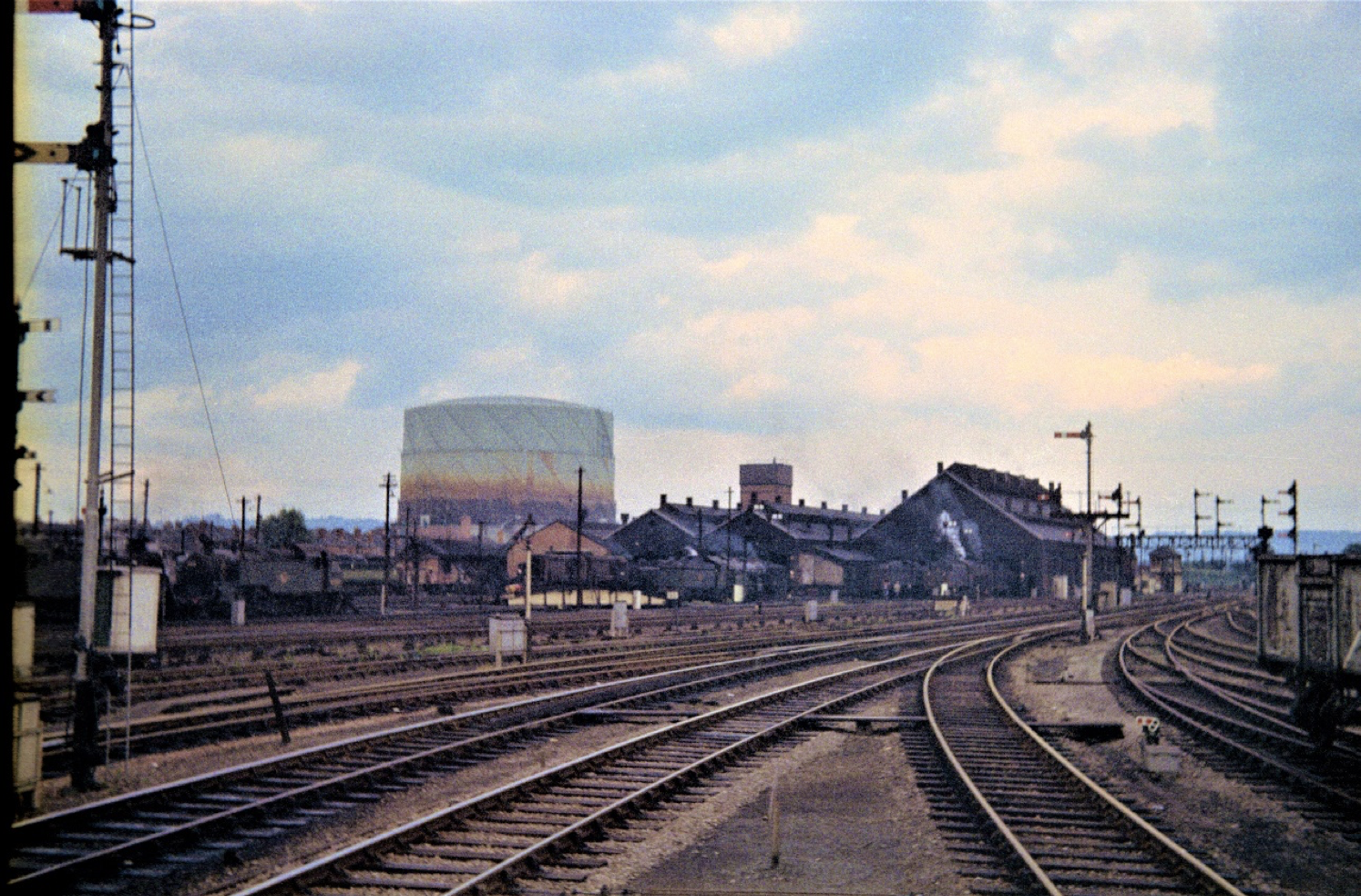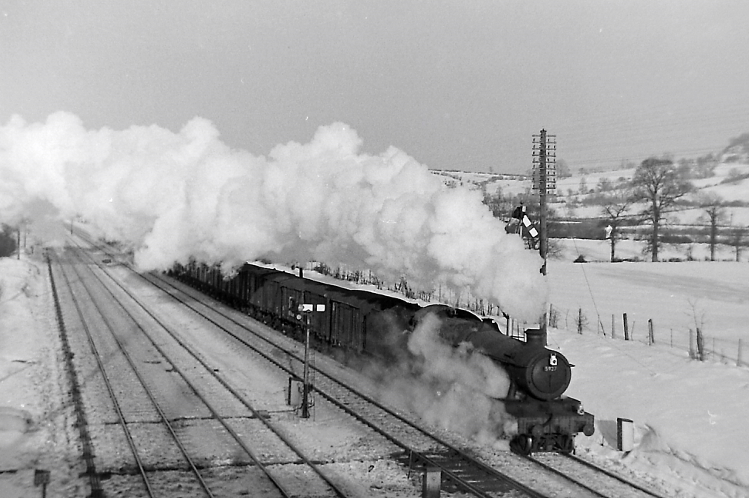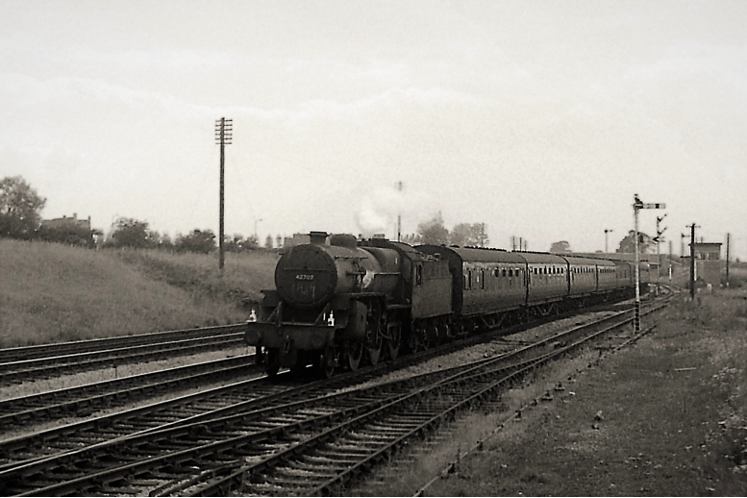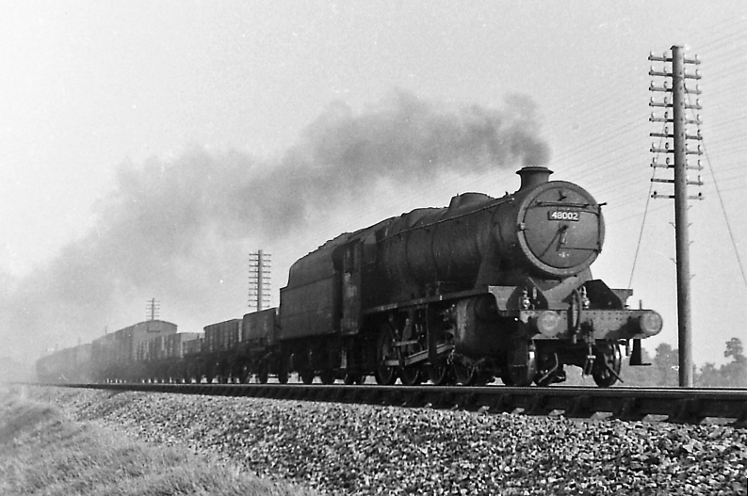1963: Leaving Home
The first two months of 1963 were marked by the coldest weather in living memory. Following 12 inches of snowfall, temperatures remained stubbornly below zero until the beginning of March. Although diesels had been introduced on most passenger services in 1962, steam haulage was still not uncommon due to diesel failures, although the awful weather made operating them a nightmare, and with steam it was impossible to adhere to the recently speeded-up schedules. I managed to take a few steam photos in Gloucester at this time, including one of ‘Hall’ No. 5927 Guild Hall at the head of a freight train at Standish Junction in the snow.
‘Hall’ Class 4-6-0 No. 5927 Guild Hall approaches Standish Junction at the head of a Bordesley Junction to Swindon fitted freight, on a sunny but freezing afternoon in January 1963.
On Sunday 3 March, with the thaw, I left home to take up my first job as a trainee cartographer at the Directorate of Overseas Surveys at Tolworth in SW London, travelling up on the afternoon train to Paddington. Strangely, I did not record the loco hauling pulling this train, nor do I have any recollection of whether it was steam- or diesel-hauled. However, by April ‘Hymeks’ had taken over most Gloucester to Paddington workings.
My only regret about these times is that whilst I was enjoying new travel experiences in London, back home in Gloucester the final days of steam were being played out, and I only chanced upon these happenings when I came home at weekends. Over one weekend home on 16 April, with Roger and Jeff I visited Ebbw Junction and Newport Pill sheds, and Caerphilly works, once the headquarters of the Rhymney Railway, but which was shortly to close. The works contained seven locos, the last to be overhauled being 2-8-0T No. 5203.
Nevertheless, unusual visitors continued to visit Gloucester, and Dave Keveren wrote to me in my early days in London, providing tantalising snippets on rare steam that I had missed, as well as describing his days as a fireman working from Barnwood shed. Some of his comments on working for BR are interesting:
“6 March 1963: fireman didn’t turn up so off I went on 44580 (21A) with 48 loaded mineral on the 6/35 Burton. Relieved at Bromsgrove. Saw D6518 on Esso (horrible!). Back on passenger.
14 March: made 12 hours on a ballast somewhere between Ashchurch and Evesham.
20 March: the day of all days. I was on 3/0 spare. Get to work and relieve the men on the Newcastle – Cardiff which was running 63 minutes late. So off we went. We took the engine out over the Western and round the loop so as to turn her. 45557 (17B) – they ride lovely the 5Xs. She had a hole full of clinker, no fire hardly. Got back to shed and straight onto 44966 (21A) LE Worcester for 6/10 Worcester – Washwood Heath. Straight back on 5/38 down slow. Got back, relieved men on the train we were on (73068), took her to shed and put her away. She had about 2ft of fire all over the box. Turned 48110 (82E) off shed, filled her up with coal and water – LE to Western shed for some job to Leamington. Walked back to shed- then home!”
Consequently, I got informed of several rare visitors, including Nos. 68070 (bound for the NCB), 42957, ‘Jubilee’ 45700 Amethyst and ‘Manor’ 7819 Hinton Manor, but perhaps the rarest arrival had been a ‘V2’, No. 60945 in January. By now Burton (17B) had amassed a large allocation of almost 20 5Xs (what Midland men always called the ‘Jubilees’), although some were soon transferred to 17A or 21A.
Other Eastern Region locomotives recorded included ‘K1’ No. 62035, which was seen on 27 June. Whilst not directly impacting on the Gloucester scene, a most unusual report must have been that of ‘A3’ Pacific No. 60039 Sandwich at the head of the 8.20 Newcastle – Swansea, which managed to reach Birmingham New Street, despite being theoretically banned south of Sheffield. Then, on 12 July 1964, an ‘A1’ Pacific, No. 60114 W P Allen managed to get as far south as Worcester!
Otherwise, my trips home at weekends allowed little chance to catch up with events in Gloucester, particularly as the London scene was new and exciting, and passenger expresses out of Waterloo to the south west were still steam-hauled. Nevertheless, whilst I was home with the family at some time during August, I enjoyed a day trip by Black & White coach to Aberystwyth to see the narrow-gauge steam locos on Vale of Rheidol railway. I also managed to take a few steam photographs locally including one of ‘Crab’ 2-6-0 No. 42707 on a summer Saturday extra at Tuffley Junction.
Hughes ‘Crab’ 2-6-0 No. 42707 coasts past Tuffley Junction under clear signals in readiness for its stop at Gloucester Eastgate with 1M17, a West-of-England to Derby extra on 17 August 1963.
Stanier ‘8F’ 2-8-0 No. 48002 lays a smokescreen as it heads west past Highnam with a Woodford Halse to Cardiff freight on 12 October 1963. By now Woodford Halse’s ‘WDs’ had been replaced by Midland locos, whilst the Oxfordshire iron ore trains were being worked by ‘9Fs’ from Banbury.
For the start of the winter timetable on September 1 1963, motive power depots in the Midlands area were reorganised, to reflect the changes to operations brought about by the bringing of ex-GW sheds into the LM Region, and Tyseley became the head depot for the Birmingham area. The Midland and Western Division LMR sheds had been amalgamated earlier in June 1960, when Saltley, the main Midland division shed was made head LMR shed of the Birmingham area: the pre-1960 codes for Western Division sheds are shown by an asterisk (*). The table below summarises the 1963 changes:
|
Previous shed code |
Name |
1963 shed code |
Closed to steam |
|
21A |
Saltley |
2E |
6.3.1967 |
|
*3A / 21B |
Bescot |
2F |
28.3.1966 |
|
*3B / 21C |
Bushbury |
2K |
12.4.1965 |
|
*3C / 21D |
Aston |
2J |
11.10.1965 |
|
*3E / 21E |
Monument Lane |
Closed |
12.2.1962 |
|
84A |
Wolverhampton Stafford Road |
Closed |
9.9.1963 |
|
84B |
Oxley |
2B |
6.3.1967 |
|
84C |
Banbury |
2D |
3.10.1966. |
|
84D |
Leamington |
2L |
14.6.1965 |
|
84E |
Tyseley |
2A |
7.11.1966 |
|
84F |
Stourbridge Junction |
2C |
11.7.1966 |
|
2F |
Woodford Halse |
1G |
14.6.1965 |



